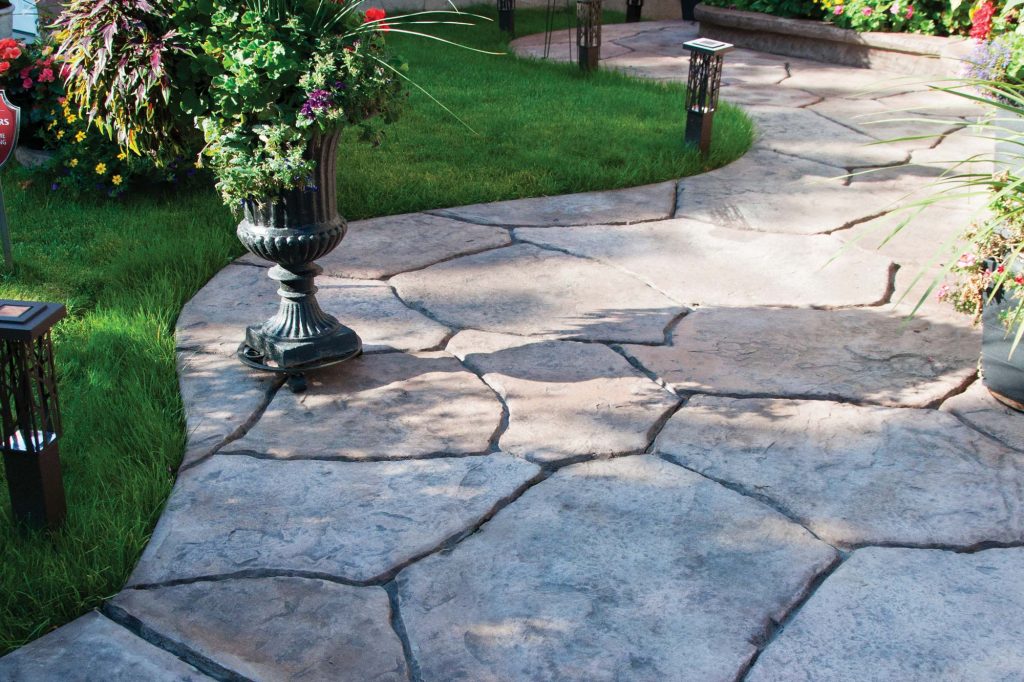Preparing Stamped Concrete For Summer
Summer is a great time for enjoying your patio. But it’s also a great time to make sure it’s in good shape. Once the snow and cold are gone, it’s good to look it over for any problems.
From there you can set it up for warm-weather enjoyment. Stamped concrete is even easier to care for in summer than in winter, but let’s look at a few tips that can help you make sure it stays that way!
Avoiding Winter Damage
As we’ve talked about when discussing winter care of stamped concrete, it’s important avoid salt for melting snow. It can damage not only the sealer on your concrete but the concrete itself.
Other products to avoid include Alaskan Melt and Polar Ice. Both of these can cause suckering in the concrete.
The first freeze-thaw cycle for your concrete is particularly important. During this time, don’t use any de-icing products unless absolutely necessary. Connie Giacomuzzi, our head of maintenance at Patterned Concrete, said:,
The most important factor in the winter is removing snow before any vehicles drive on the surface. If snow is removed before it is driven on, then [the] use of aggressive scraping and cleaning is not required. You will find that once the snow is removed your concrete will not be slippery and will not require any deicing materials to aid in the removal. De-icing materials can damage your concrete so only use if required.
Instead, brick sand is a great alternative. Apply it wherever moisture may refreeze. It will lock in the moisture and provide traction at the same time.
Watch For Cracks
Once winter is done, be on the lookout for is any cracking that appears in your cement. Don’t misunderstand; cracking can happen any time, not only over winter. As Connie, our maintenance specialist at Patterned Concrete, says, “drastic heat changes can be worse in areas where there is no freeze-thaw cycle.”

However, spring and summer are a good time to look for any issues that have developed over the past year. In the fall and winter, you have to deal with leaves and snow, making issues harder to detect. Once those are gone, though, you can see any hairline cracks that may have formed.
Careful engineering of the surface helps eliminate or control most cracks. Hairline cracks cdan still appear, though. However, they may only be visible after it rains since they tend to dry more slowly than the surrounding area.
If you notice that a crack has shifted or become wider, then there could be more serious issues. If you’re worried about what you see, send a photo of it to our maintenance department. Connie can have a look and maybe schedule a visit to see what the next steps should be.
Is It Time To Get The Surface Sealed?
Spring and early summer are also great times to reseal your patio or driveway. This should normally take place every three years.
“Natural penetrating sealer is the best option as it resembles and behaves like natural stone for a fraction of the cost,” says Connie. This is what we use at Patterned Concrete. If you decide to do the sealing as a DIY job, you can get it from Concreation Canada.
You need warm – but not hot – weather to apply sealer effectively. You also need to apply it to dry concrete. Make sure the surface is already dry and that you have a couple of clear days in the forecast. This will let the sealer dry thoroughly before the rain hits it again.
There are two issues that often arise if the sealer isn’t properly applied.

If bubbles appear, the layer is likely too thick. The weather could also be too hot. Be sure to follow the manufacturer’s instructions, including the temperature recommendations. Bubbling can also occur if the concrete is exposed to direct sunlight, so try to choose “off times” when the sun isn’t beating down hard.
If you experience peeling, flaking, or a white or filmy look, it’s likely because the concrete was wet when the sealer was applied. The sealer needs to adhere directly to the concrete, but a layer of water has blocked it.
Over time sealer wears off. But if it is laid too thickly and then a next layer is laid on top of it, moisture can be trapped between the layers, making the surface look milky or white.
Of course, if you’d rather avoid the hassle, you can always get in touch with us to make sure your stamped concrete is sealed correctly.
Do You Need To Strip? (Your Stamped Concrete, That Is)
We’re often asked whether it’s necessary to strip old sealer off stamped concrete before applying a new layer. According to Connie, who has over 20 years’ experience in the industry, it usually is not necessary;
“If you are an older job before the early 2000s, stripping is recommended because sealer might have been applied in excess causing an unsightly build-up on concrete. Once concrete has been stripped it does not need to be stripped again because from that point on sealer will be applied every 3 years.”.
So it’s a rare case where you’ll need to strip your concrete, at least if it was done by us. The normal cycle of sealing doesn’t cause unwanted buildup.
Power Washing
If everything else is in good shape, you’re ready to get that patio or driveway cleaned up and looking great! You can use a power washer to make sure that all the dirt and grime is washed away. This is a great way to get in all the grooves, corners, and edges that you might miss otherwise.
Concreation offers great cleaning supplies for concrete. If you have stains from leaves or tire stains, they can recommend a soap with a neutral pH of less than 9. These soaps are great on stamped concrete.
Tougher stains like tar or oil may require a degreaser or solvent cleaner first. Your concrete sealer will let the stain come out just as it let it soak in. In fact, always be sure to try the neutral soap first – it will get out most oil stains even without a degreaser!
Made In The Shade

Got your concrete in good shape and ready to go? Make it more enjoyable by adding some shade! A patio umbrella or pergola is a great way to add to the fun. It will provide you with a shaded space to enjoy without getting burned. At the same time, it spares your surface from the pounding rays.
Everything In Its Place
Concrete is tough – very tough. But remember that it can still be chipped or damaged. Do your best to protect it by keeping sharp tools off the surface. While you may need to ride your lawnmower across your driveway, check that the blade is high enough so it won’t scrape the concrete’s edges.
Shovels, rakes, and the like can also accidentally scrape the sealer and the surface itself. Be careful not to drop or drag them on concrete. It’s best to avoid laying them on the surface, too, because they could be kicked or moved and their blades could do unexpected damage.
Conclusion
When you’ve made the investment in stamped concrete, you want to be able to enjoy it whenever the weather permits. The early part of summer is great for making sure it’s in great shape. At the beginning of the season, check the patio for any issues, have it sealed if necessary, and clean it up. Add some shade and a comfy chair and you’ll be well on your way to maximizing your summer enjoyment!